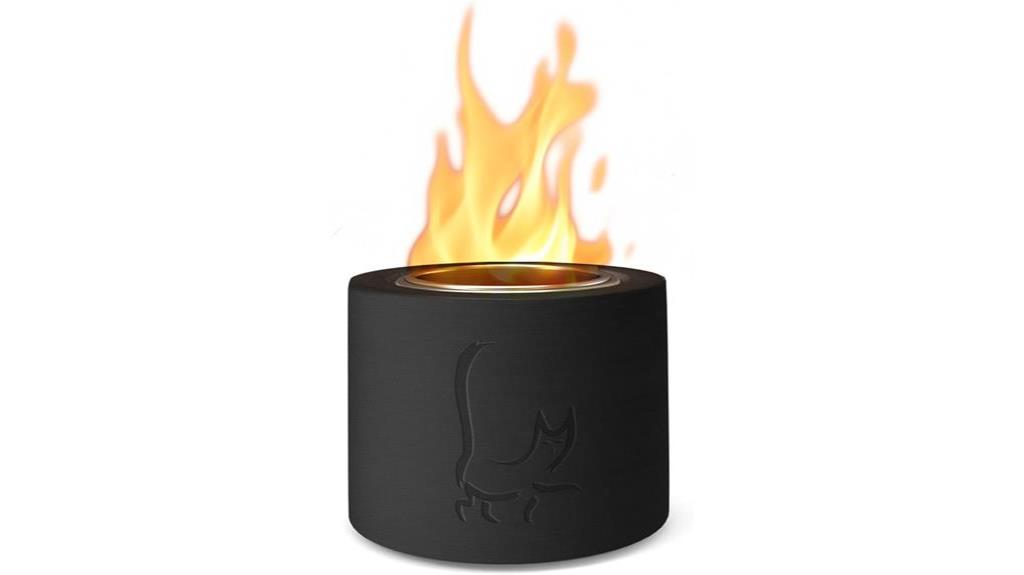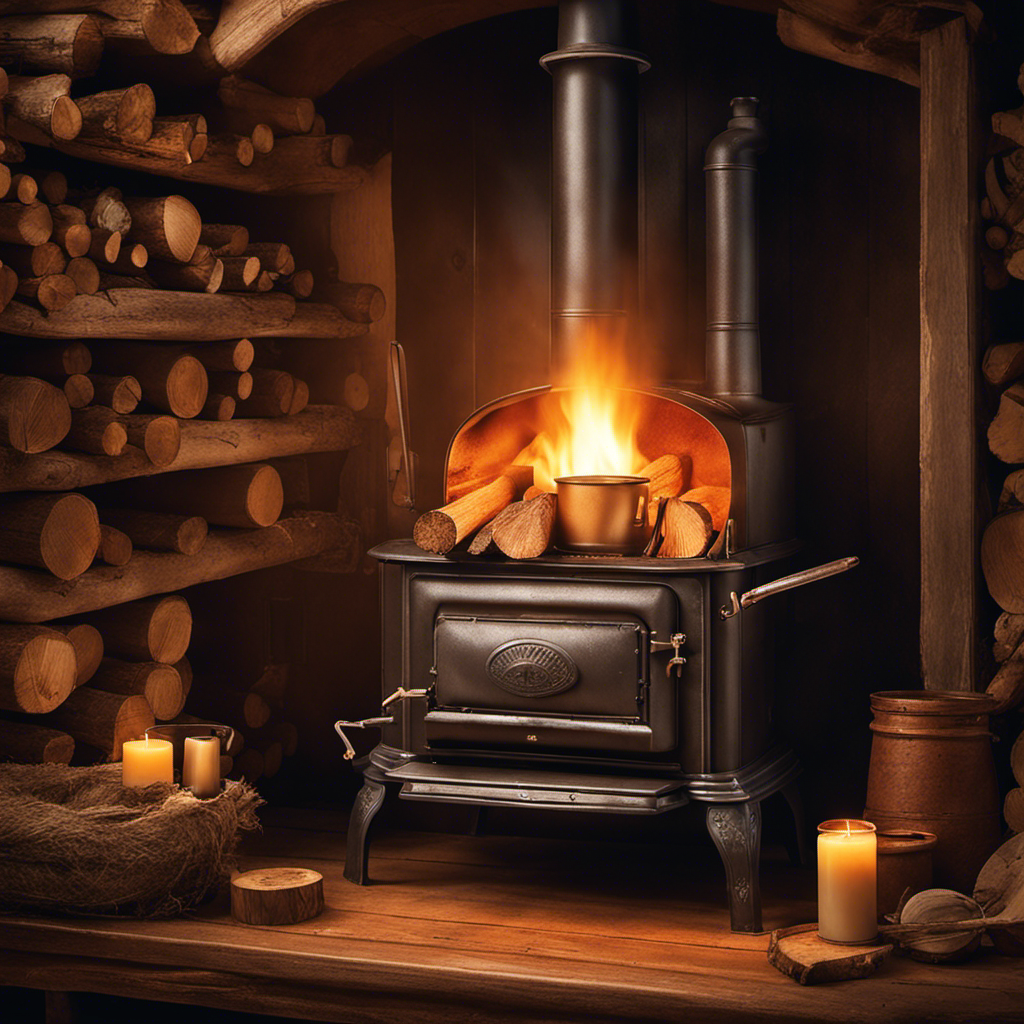Wood Stove
How To First Fire Vogelzang Wood Stove

I have always been fascinated by how efficient and effective wood stoves are.
Did you know that using a Vogelzang wood stove can reduce your heating costs by up to 30%?
In this article, I’ll guide you through the process of first firing your Vogelzang wood stove.
From checking the components to adjusting the airflow, you’ll learn the necessary steps to ensure a safe and efficient fire.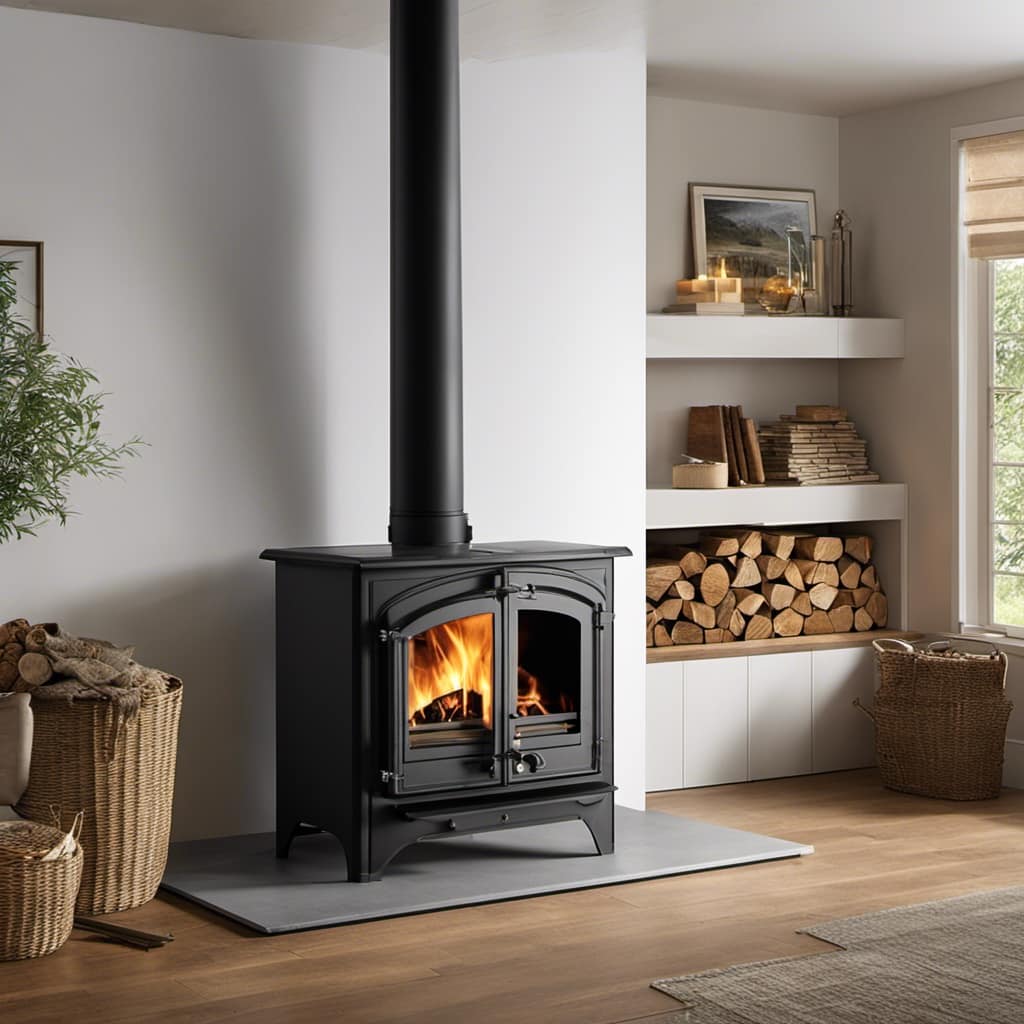
Let’s get started and harness the warmth of your wood stove!
Key Takeaways
- Inspect the firebox, door, and chimney for damage or wear
- Arrange kindling and logs for proper airflow and combustion
- Use hardwoods like oak, maple, and birch for slow and efficient burning
- Place small pieces of dry kindling at the bottom of the stove
Checking the Components and Safety Precautions
I’m checking the components and taking safety precautions before using the Vogelzang wood stove.
The first thing I do is inspect the components to ensure everything is in proper working condition. I examine the firebox, the door, and the chimney for any signs of damage or wear. I also check the gaskets and seals to make sure they’re intact and functioning correctly.
Next, I take safety measures to prevent any accidents or mishaps. I ensure there’s a fire extinguisher nearby and that smoke detectors are working properly. I also make sure the stove is placed on a non-combustible surface and that there’s a clear area around it.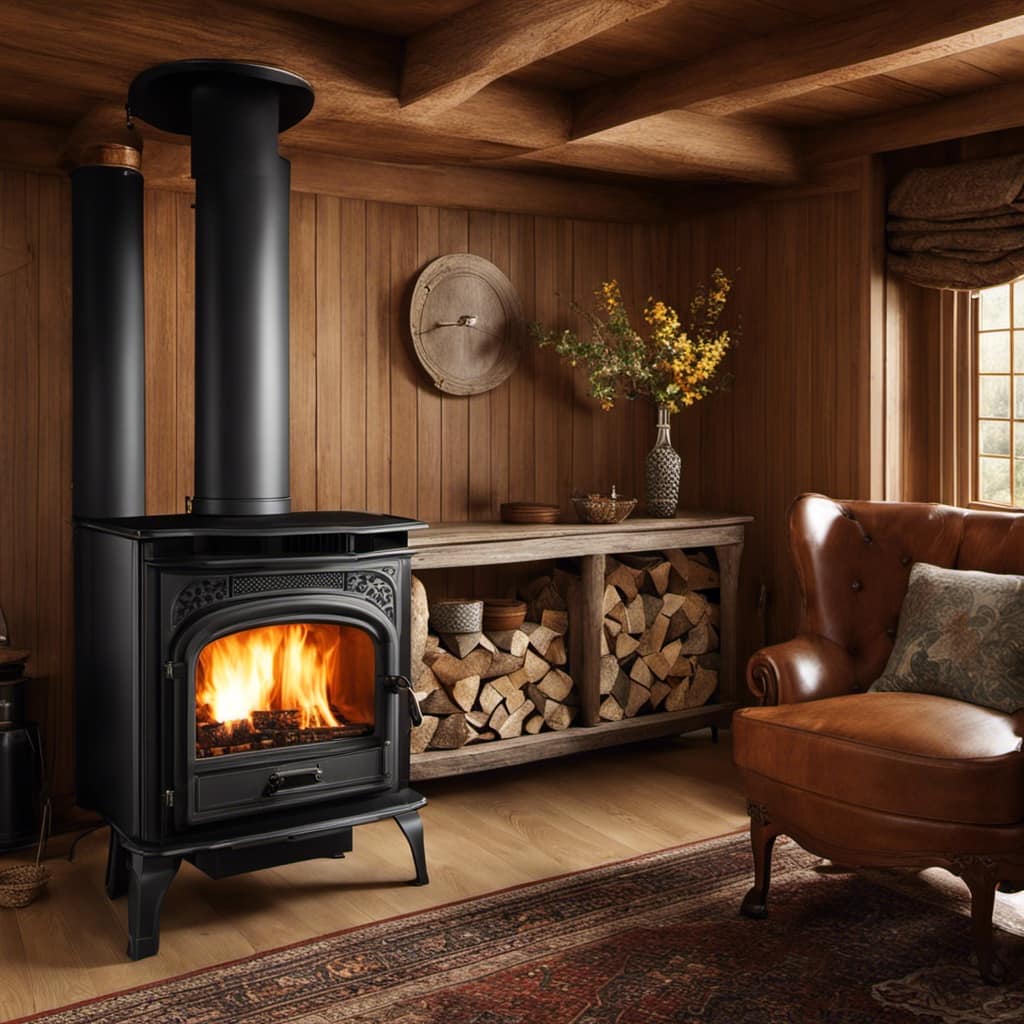
Following these component inspections and safety measures, I feel confident and ready to start my first fire in the Vogelzang wood stove.
Preparing the Wood and the Stove
Before starting the fire, I carefully arrange the kindling and logs in the wood stove to ensure proper airflow and efficient combustion. Choosing the right firewood is crucial for a successful and long-lasting fire.
Hardwoods such as oak, maple, and birch are ideal as they burn slowly and produce more heat. Softwoods like pine and cedar, on the other hand, burn faster and are great for getting the fire started.
Properly stacking the wood is also important. I make sure to leave enough space between the logs for air to circulate, allowing the fire to breathe. Additionally, I stack the wood in a crisscross pattern, creating a stable structure that promotes even burning.
Building the Fire Properly
To build the fire properly, I add newspaper and kindling to the wood stove.
Fire safety is of utmost importance, so it’s crucial to ensure that the firewood is stored correctly. It should be kept in a dry and well-ventilated area, away from any flammable materials. This helps prevent the risk of accidental fires.
Once I’ve placed the newspaper and kindling in the stove, I carefully arrange the firewood on top, making sure to leave enough space for air circulation. This allows for proper combustion and efficient heat output.
With the firewood properly stored and the fire set up, I can now move on to igniting the fire and adjusting the airflow to achieve the desired temperature and burn rate.
Igniting the Fire and Adjusting the Airflow
I carefully ignite the fire and adjust the airflow to ensure efficient heat distribution and maintain the desired temperature in the wood stove. Here’s a step-by-step guide on how to do it:
Ignition: Start by placing small pieces of dry kindling at the bottom of the stove. Then, carefully light the kindling using a match or a lighter. Make sure to keep the stove door slightly ajar to allow proper airflow.
Airflow Adjustment: Once the fire is lit, adjust the air intake damper to control the amount of oxygen entering the stove. This will help regulate the burn rate and temperature. Opening the damper will increase airflow, resulting in a hotter fire, while closing it will reduce airflow and lower the temperature.
Temperature Control: To maintain the desired temperature, monitor the thermometer on the stove. If the temperature gets too high, reduce the airflow by partially closing the damper. Conversely, if the temperature is too low, increase airflow by opening the damper slightly.
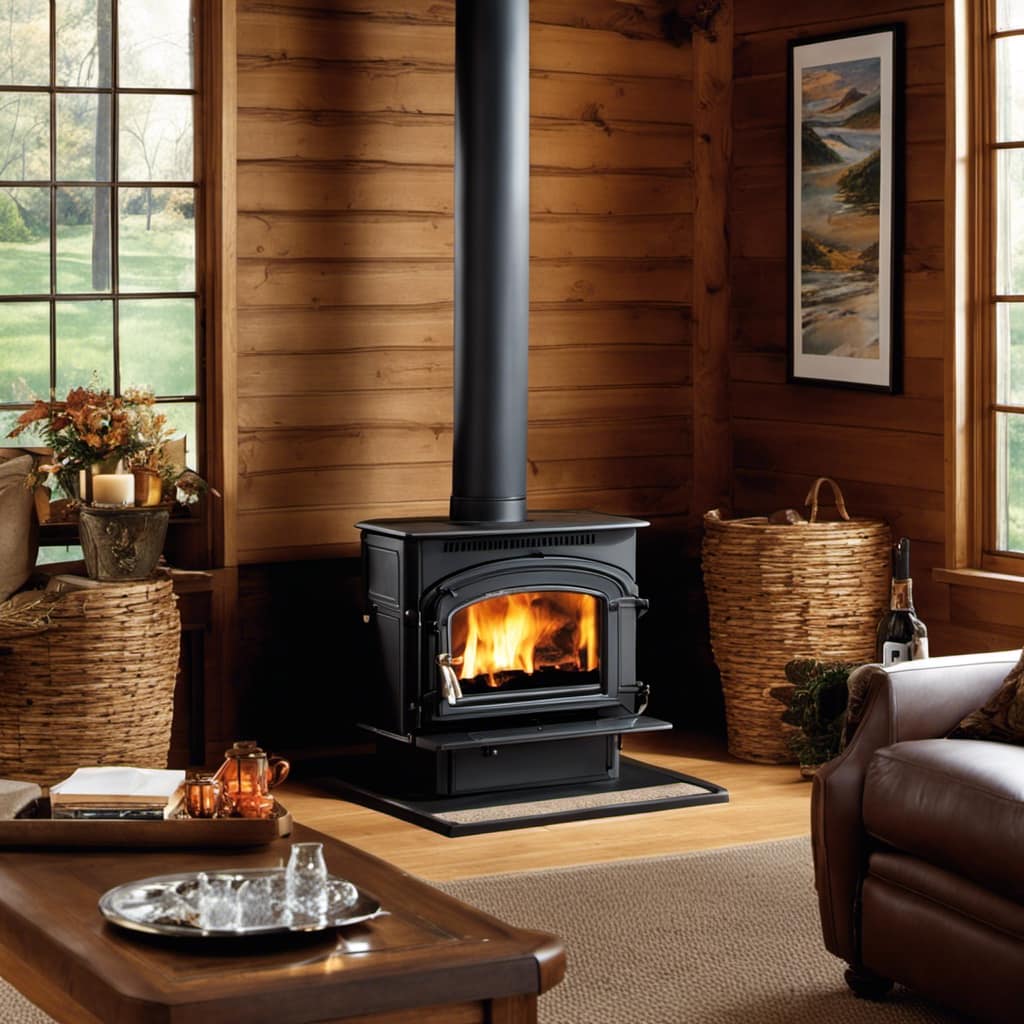
Troubleshooting Common Issues: If you encounter issues like a smoky fire or difficulty in igniting, check if the damper is fully open and if the chimney is clear of any obstructions. Additionally, make sure the wood is dry and properly seasoned to ensure efficient burning.
Monitoring and Maintaining the Fire
How often should I check the wood stove to ensure the fire is burning properly?
When it comes to monitoring and maintaining the fire in a wood stove, regular checks are crucial. I recommend checking the wood stove every 30 minutes to ensure the fire is burning at an optimal level. This allows you to make any necessary adjustments to the airflow and keep the firewood burning efficiently.
Additionally, it’s important to have a proper firewood storage system in place. This ensures that the firewood is dry and seasoned, which helps maintain a steady and efficient burn.
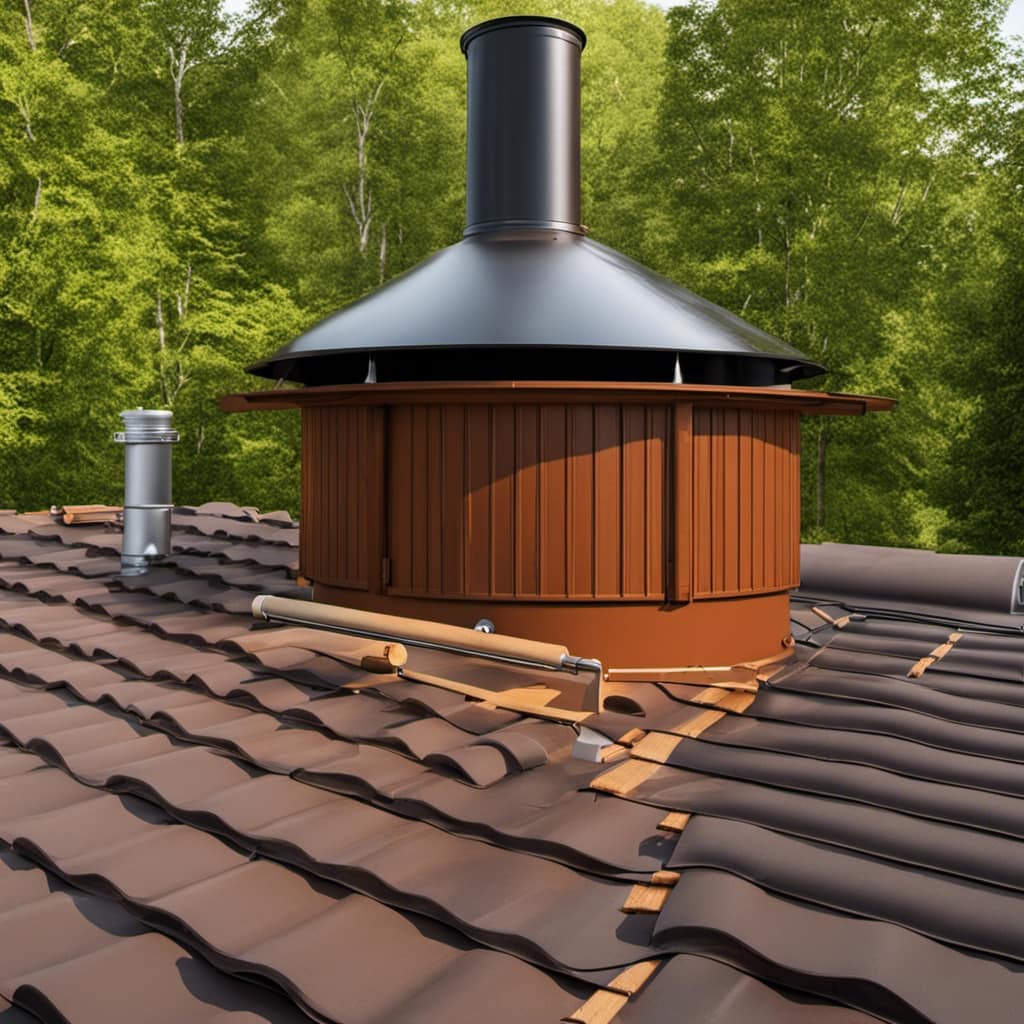
Lastly, don’t forget to clean the ashtray regularly. This prevents ash buildup, allowing for proper airflow and preventing any potential fire hazards.
Can the same method be used to fire a wood stove in a video game as in real life?
In the video game, replicating the exact method to fire a wood stove in house as in real life may not be necessary. However, for a realistic gaming experience, incorporating the same steps such as gathering wood, arranging the logs, and igniting the fire can add immersion and authenticity.
Frequently Asked Questions
How Long Does It Typically Take for a Vogelzang Wood Stove to Heat up a Room?
Typically, it takes about 30 minutes for a Vogelzang wood stove to heat up a room. To maximize heat output, ensure proper maintenance by cleaning the stove regularly and using dry, seasoned wood.
Can I Use Any Type of Wood in My Vogelzang Wood Stove?
I can use different types of wood in my Vogelzang wood stove, but proper wood storage is important. It’s like choosing the right ingredients for a recipe, ensuring a smooth and efficient burn.
Is It Necessary to Clean the Chimney Regularly When Using a Vogelzang Wood Stove?
Regular chimney cleaning is crucial when using a Vogelzang wood stove. It ensures proper airflow, prevents chimney fires, and prolongs the stove’s lifespan. Remember to schedule annual inspections and cleanings to maintain optimal performance and safety.
What Are Some Common Signs That Indicate My Vogelzang Wood Stove Needs Maintenance?
When my Vogelzang wood stove started smoking excessively, I realized it needed maintenance. Common signs include poor draft, difficulty starting a fire, and black soot buildup. Troubleshoot by checking the chimney, gaskets, and air vents.
Are There Any Specific Guidelines for Safely Extinguishing the Fire in a Vogelzang Wood Stove?
When it comes to safely extinguishing a fire in a Vogelzang wood stove, it is crucial to follow specific guidelines. Additionally, proper maintenance is essential to ensure the stove functions efficiently and safely.
Conclusion
In conclusion, firing up your Vogelzang wood stove is a simple process that requires careful preparation and attention to detail. By following the safety precautions, properly preparing the wood, and building the fire correctly, you can enjoy a warm and cozy fire in no time.
Remember, ‘where there’s smoke, there’s fire’ – so keep an eye on the airflow and maintain the fire to ensure a safe and enjoyable experience.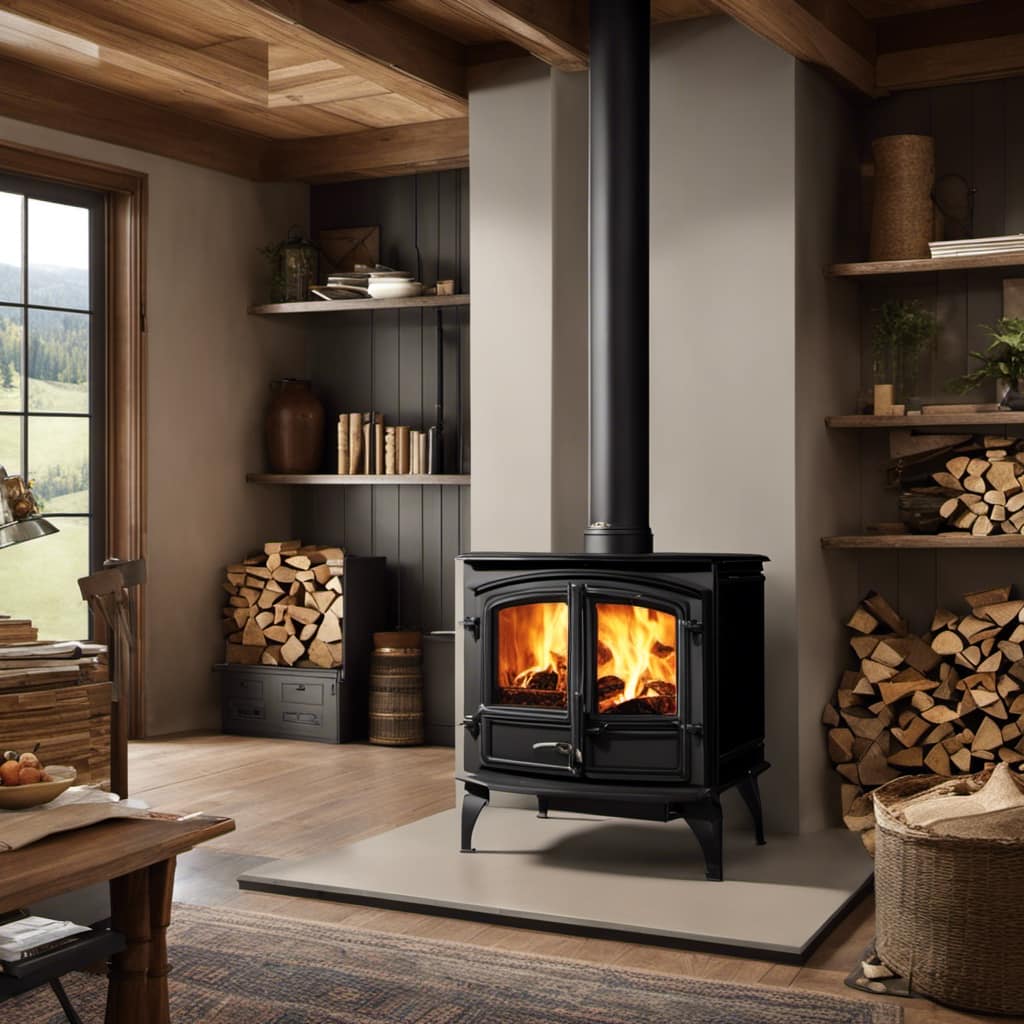
Growing up surrounded by the vast beauty of nature, Sierra was always drawn to the call of the wild. While others sought the comfort of the familiar, she ventured out, embracing the unpredictable and finding stories in the heartbeat of nature.
At the epicenter of every remarkable venture lies a dynamic team—a fusion of diverse talents, visions, and passions. The essence of Best Small Wood Stoves is crafted and refined by such a trio: Sierra, Logan, and Terra. Their collective expertise has transformed the platform into a leading authority on small wood stoves, radiating warmth and knowledge in equal measure.
Wood Stove
How To Tell If Wood Stove Is To Hot
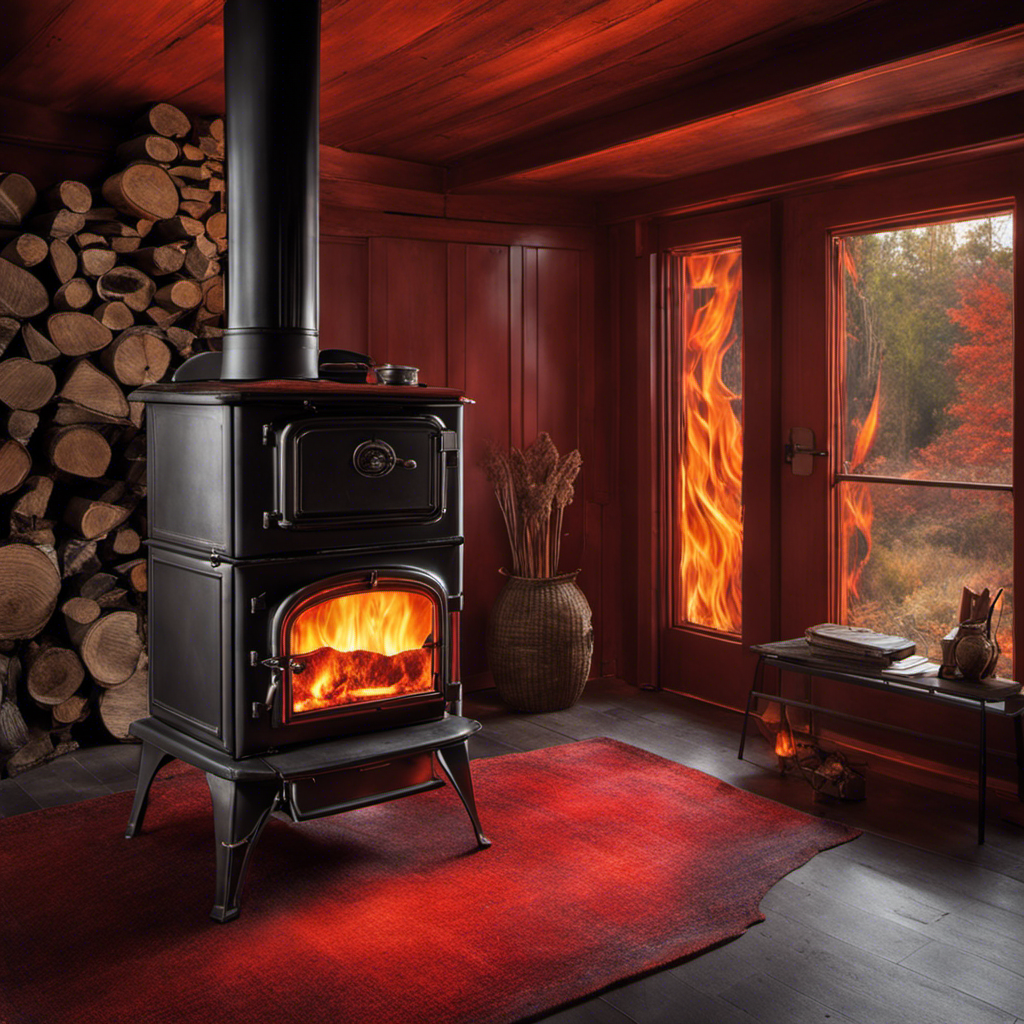
Sitting next to my wood-burning stove, I am enveloped by the warmth emanating from its bright, glowing embers.
But how do I know if it’s too hot?
In this article, I’ll guide you through the essential steps to determine if your wood stove is exceeding safe temperatures.
From checking the temperature gauge readings to observing smoke and flames, we’ll explore various methods to ensure your wood stove remains in a safe operating range.
Let’s keep our homes cozy and secure.
Key Takeaways
- Monitoring the temperature gauge readings is crucial for maintaining optimal heat levels and preventing overheating.
- Checking the exterior temperature of the wood stove using a digital thermometer helps ensure it is operating within safe limits.
- Observing flame color, assessing airflow and draft, and monitoring smoke and flame characteristics are important for determining if the stove is operating at a safe temperature.
- Regularly inspecting and maintaining the firebox and hearth is essential for the safety and efficiency of the wood stove.
Temperature Gauge Readings
I’m keeping an eye on the temperature gauge readings to make sure my wood stove doesn’t get too hot. Understanding heat distribution and the importance of proper airflow are key factors in maintaining the optimal temperature for a wood stove.
The temperature gauge provides crucial information about the heat levels inside the stove, allowing me to adjust the airflow accordingly. If the temperature exceeds the recommended range, it could lead to overheating and potential damage to the stove or surrounding areas.
Proper airflow ensures that the heat is distributed evenly throughout the stove, preventing hot spots and allowing for efficient combustion. By monitoring the temperature gauge readings, I can ensure that the wood stove operates at a safe and effective temperature, promoting both comfort and safety.
Now, let’s move on to checking the exterior temperature.
Checking the Exterior Temperature
There are a few ways to check the exterior temperature, but one option is to use a digital thermometer.
When using a digital thermometer to check the temperature of a wood stove, it’s important to take certain safety precautions. First, ensure that the stove is completely cool before attempting to measure the temperature. This will prevent any burns or injuries. Next, make sure to hold the thermometer at a safe distance from the stove to avoid any contact with hot surfaces.
It’s also important to regularly clean and maintain the thermometer to ensure accurate readings. This can be done by wiping it with a soft cloth and checking the battery life periodically.
By following these safety precautions and maintenance tips, you can effectively check the exterior temperature of your wood stove without any risks.
Now, let’s move on to observing smoke and flames.
Observing Smoke and Flames
I can see both thick smoke and bright flames coming out of the wood stove. As a wood stove enthusiast, I understand the importance of closely monitoring the flame color and assessing the airflow and draft in order to determine if the stove is operating at a safe temperature. By conducting a flame color analysis, we can gain valuable insights into the combustion process and the stove’s efficiency. A blue flame indicates complete combustion, while a yellow or orange flame suggests incomplete combustion and potential overheating. Additionally, assessing the airflow and draft is crucial. Proper airflow ensures efficient burning and prevents excessive heat buildup. Monitoring the smoke and flame characteristics allows us to make informed decisions and maintain the wood stove’s optimal operating conditions.
| Flame Color | Airflow Assessment | Draft Assessment |
|---|---|---|
| Blue | Adequate | Strong |
| Yellow | Insufficient | Weak |
| Orange | Insufficient | Weak |
Examining the Firebox and Hearth
When examining the firebox and hearth, it’s important to check for any signs of cracks or damage that could compromise the safety and efficiency of the wood stove. Firebox maintenance is crucial to ensure that the stove is functioning properly and to prevent any potential hazards.
Inspect the firebox for any cracks, as they can lead to heat loss and potential fire hazards. Additionally, check for any damage to the bricks or mortar, as this can also affect the stove’s efficiency.
The hearth design is also important, as it should be made of non-combustible materials and extend a safe distance from the stove. The hearth acts as a protective barrier, preventing any sparks or embers from reaching flammable surfaces.
Regularly inspecting and maintaining the firebox and hearth is essential for the safe and efficient operation of a wood stove.
Using a Heat-Sensing Device
I can easily determine the temperature of my wood stove using a heat-sensing device. By utilizing an infrared thermometer or a thermal imaging camera, I can accurately measure the heat produced by my wood stove.
Here is how I do it:
-
Select the appropriate device: Depending on the level of accuracy and detail required, I choose either an infrared thermometer or a thermal imaging camera.
-
Prepare the device: Ensure that the device is fully charged or has fresh batteries. Also, make sure that the lens or sensor is clean and free from any obstructions.
-
Measure the temperature: Point the device towards the desired area on the wood stove and press the trigger or button to capture the temperature reading. Repeat this process for different parts of the stove, including the door, flue, and chimney.
Using an infrared thermometer or a thermal imaging camera provides me with valuable information about the temperature of my wood stove, allowing me to ensure its safe and efficient operation.
Frequently Asked Questions
How Often Should I Clean My Wood Stove to Ensure It Doesn’t Get Too Hot?
I clean my wood stove every 1-2 months to prevent it from overheating. Leaving a wood stove unattended while it’s burning can be dangerous as it can lead to a buildup of creosote and other combustible materials.
Can I Leave My Wood Stove Unattended While It Is Burning?
Leaving a wood stove unattended while it’s burning can pose serious safety concerns. It’s important to always monitor the stove to ensure it doesn’t overheat or cause any potential fire hazards.
What Are the Potential Dangers of a Wood Stove Getting Too Hot?
Potential health risks of an overheating wood stove include carbon monoxide poisoning and the risk of fire. Signs of an overheating wood stove may include excessive heat emanating from the stove, warping or discoloration of the stove, and unusual noises.
Are There Any Specific Types of Wood That Burn Hotter and Could Cause the Stove to Overheat?
Some types of wood, like oak or hickory, burn hotter and can potentially cause a wood stove to overheat. To prevent this, ensure proper ventilation, monitor the stove’s temperature, and use a heat-resistant barrier.
Is It Possible for a Wood Stove to Get Too Hot Even if the Temperature Gauge Readings Are Within the Recommended Range?
It is indeed possible for a wood stove to become too hot, even if the temperature gauge readings are within the recommended range. Signs of overheating in a wood stove and how to regulate the heat output are important to address.
Conclusion
In conclusion, it’s crucial to monitor the temperature of a wood stove to ensure safety and efficiency.
One interesting statistic to note is that according to a study conducted by the National Fire Protection Association, heating equipment, including wood stoves, is responsible for approximately 15% of home fire deaths in the United States.
By following the outlined methods for checking the temperature of a wood stove, homeowners can effectively prevent overheating and reduce the risk of fire accidents.
Logan’s affair with adventure began in childhood. He hailed from a small town where vast forests bordered one side and endless shores stretched on the other. His days were spent exploring uncharted woods, climbing tall trees, or listening to the tales of old sailors. This early immersion in a world brimming with stories and mysteries became the foundation of his passion for writing.
Wood Stove
What Do I Need To Put A Wood Stove In My House
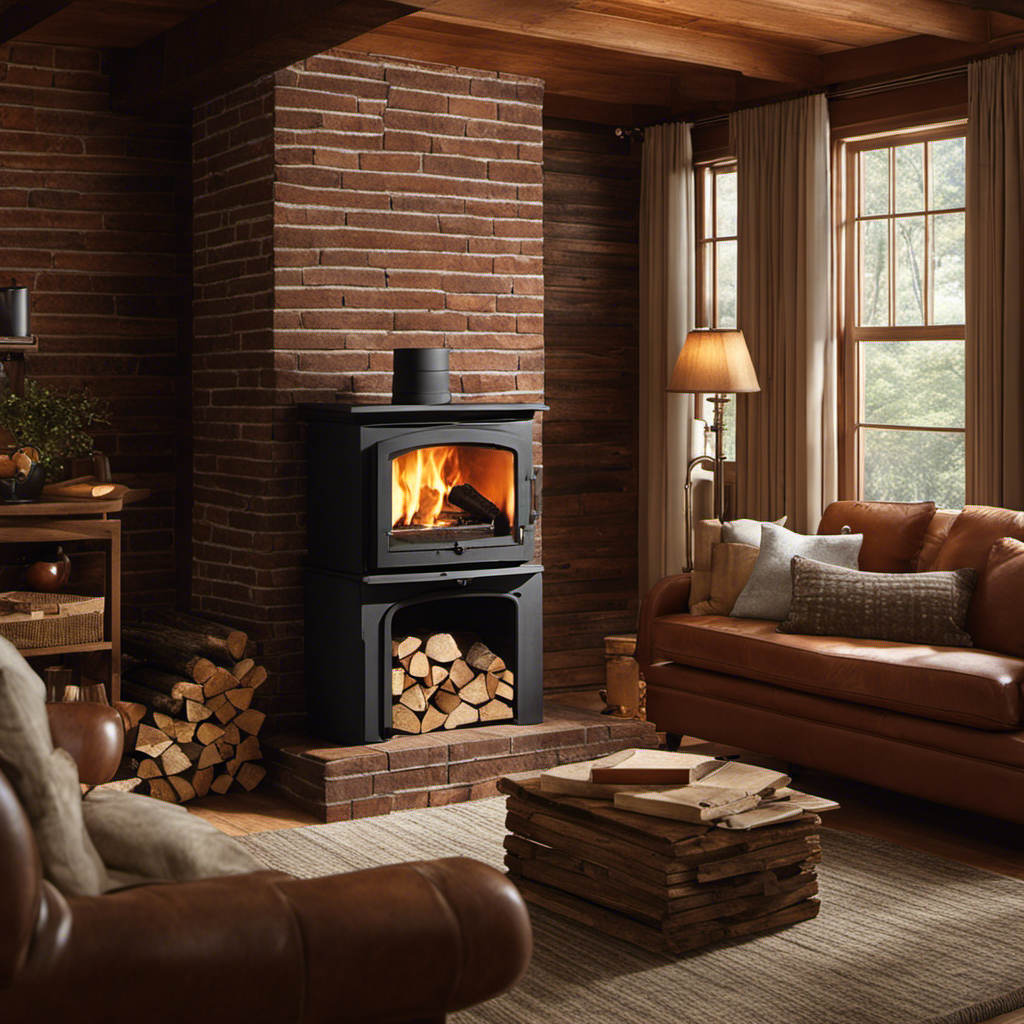
As a homeowner, I’ve consistently been attracted to the cozy warmth and delightful allure of having a wood stove in my home.
But before I embark on this exciting project, I need to be well-informed about the necessary requirements. From safety considerations to permits and regulations, proper ventilation to clearances and placement, there’s a lot to consider.
In this article, I’ll guide you through the essential tools and materials needed to successfully install a wood stove in your home.
Let’s get started!
Key Takeaways
- Follow manufacturer’s guidelines for installation and maintenance
- Research and understand local building codes and regulations
- Choose appropriate size and type of ventilation system
- Maintain minimum distance between stove and combustible materials
Safety Considerations
I need to carefully consider the safety precautions before installing a wood stove in my house. Fire prevention is of utmost importance when it comes to wood stoves. To minimize the risk of fire, it’s crucial to follow the manufacturer’s guidelines for installation and maintenance. This includes ensuring proper clearance between the stove and any combustible materials, such as furniture or curtains.
Additionally, installing a fireproof hearth and using a spark arrestor on the chimney can further reduce fire hazards. Another significant safety concern is the risk of carbon monoxide poisoning. Wood stoves produce this odorless and deadly gas, so it’s essential to have a functioning carbon monoxide detector installed near the stove. Regular maintenance and proper ventilation are also necessary to prevent the accumulation of carbon monoxide. Taking these safety precautions will help ensure a secure wood stove installation.
Now, let’s move on to the next topic: permits and regulations.
Permits and Regulations
Obtaining the necessary permits and adhering to the local regulations is vital when installing a wood stove in my home. Building codes and insurance requirements play a crucial role in ensuring the safety and legality of the installation process.
Before beginning the installation, it’s essential to research and understand the specific building codes and regulations set by the local authorities. These codes outline the minimum standards for safety and provide guidelines for placement, clearance, and venting requirements. Failure to comply with these codes can result in fines, penalties, or even having to remove the wood stove altogether.
Additionally, insurance companies often require proof of compliance with building codes and regulations before providing coverage for any potential damages or accidents. Therefore, it’s crucial to obtain the necessary permits and adhere to the local regulations to ensure a safe and legal wood stove installation in my home.
Speaking of safety, proper ventilation is another critical aspect to consider when installing a wood stove.
Proper Ventilation
The article explains the importance of proper ventilation when installing a wood stove in my home. It’s crucial to have a well-designed ventilation system to ensure proper air circulation and prevent the buildup of harmful gases and pollutants.
Here are some key points to consider:
- Choose the right size and type of ventilation system that suits your wood stove and the size of your home.
- Install a chimney or flue pipe that’s properly insulated and meets the required safety standards.
- Position the stove in an area that allows for efficient airflow and easy access for cleaning and maintenance.
- Regularly clean and inspect the ventilation system to remove any creosote buildup and ensure optimal performance.
Proper ventilation is essential for the safe and effective operation of a wood stove. A well-designed system won’t only provide better air quality but also prevent potential hazards.
Clearances and Placement
Before installing my wood stove, I need to carefully consider clearances and placement to ensure proper safety and functionality. Clearances refer to the minimum distance required between the stove and any combustible materials. This includes walls, furniture, and flooring. To prevent any fire hazards, it’s crucial to have fireproof flooring, such as tile or brick, installed around the stove.
Additionally, the stove should be placed in an area where it can be easily accessed for maintenance and cleaning. Another important aspect is chimney installation. The stove should be connected to a properly sized and installed chimney that can effectively vent the smoke and gases produced.
It’s recommended to consult with a professional to ensure compliance with local codes and regulations for optimal safety and performance.
Tools and Materials Needed
What tools and materials do I need to properly install a wood stove in my house? Sourcing the right equipment is crucial for a successful installation process. Here are the essential tools and materials you’ll need:
- Wood stove: Choose a model that suits your heating needs and fits the available space.
- Chimney pipe: Ensure proper ventilation by selecting the correct size and type of chimney pipe.
- Stovepipe: Connect the wood stove to the chimney pipe using a stovepipe, which should be made of durable materials.
- Hearth pad: Protect your floor from heat and potential fire hazards with a non-combustible hearth pad.
To ensure a safe and efficient wood stove installation, it’s recommended to consult a professional or follow the manufacturer’s guidelines. Properly sourcing these tools and materials will help you enjoy the warmth and comfort of a wood stove in your home.
Frequently Asked Questions
How Much Does It Cost to Install a Wood Stove in a House?
Installing a wood stove in a house can vary in cost depending on factors such as stove type, installation materials, and labor. It is important to consider the cost comparison and environmental impact before making a decision.
Can I Install a Wood Stove Myself, or Do I Need to Hire a Professional?
Installing a wood stove requires expertise to ensure safety and efficiency. Hiring a professional offers the benefits of their knowledge and experience. Don’t risk it. Let the experts handle it.
Are There Any Specific Requirements for the Type of Wood I Can Use in a Wood Stove?
There are specific requirements for the type of wood used in a wood stove. It needs to be well-seasoned and dry, with a moisture content of less than 20%. Hardwoods like oak and maple are recommended.
How Often Do I Need to Clean and Maintain a Wood Stove?
I clean and maintain my wood stove regularly to ensure it functions properly. Cleaning frequency depends on usage, but I recommend at least once a month. Common maintenance issues include cleaning the chimney and replacing worn-out gaskets.
Are There Any Tax Incentives or Rebates Available for Installing a Wood Stove in My House?
Tax incentives and rebates may be available for installing a wood stove. These incentives are typically offered to promote energy efficiency and reduce reliance on fossil fuels. It’s important to research and comply with local regulations and requirements.
Conclusion
In conclusion, adding a wood stove to your house can be a great way to enhance both the aesthetics and functionality of your space.
However, it’s crucial to prioritize safety and follow all necessary permits and regulations. Proper ventilation, clearances, and placement are key factors to consider.
By taking these precautions and using the right tools and materials, you can enjoy the warmth and charm of a wood stove while ensuring a safe and comfortable environment for your home.
Growing up surrounded by the vast beauty of nature, Sierra was always drawn to the call of the wild. While others sought the comfort of the familiar, she ventured out, embracing the unpredictable and finding stories in the heartbeat of nature.
At the epicenter of every remarkable venture lies a dynamic team—a fusion of diverse talents, visions, and passions. The essence of Best Small Wood Stoves is crafted and refined by such a trio: Sierra, Logan, and Terra. Their collective expertise has transformed the platform into a leading authority on small wood stoves, radiating warmth and knowledge in equal measure.
Wood Stove
How Safe Is A Double Barrel Wood Stove

As a person deeply fascinated by wood stoves, I was eager to disclose my discoveries related to the safety aspects of double-barrel wood stoves. Owing to their distinctive construction and effective heating properties, these stoves are steadily gaining favor with homeowners.
But are they really safe? In this article, we will delve into the construction, ventilation systems, and safety precautions associated with double barrel wood stoves.
Stay tuned to learn how to minimize risks and ensure a secure and cozy heating experience.
Key Takeaways
- Proper ventilation and smoke control systems are crucial for safe operation of a double barrel wood stove.
- Following manufacturer’s instructions and safety precautions is important for installation and operation.
- Regular cleaning and maintenance of the stove and chimney reduces fire risk and improves efficiency.
- Taking precautions to minimize potential risks, such as installing a carbon monoxide detector and heat shield, can enhance safety when using a double barrel wood stove.
The Construction and Design of Double Barrel Wood Stoves
I think the construction and design of double barrel wood stoves is fascinating. These stoves are engineered to maximize efficiency and heat distribution, ensuring that the most heat possible is generated from the burning wood. The double barrel design allows for better airflow, which helps in achieving a more efficient burn and distributing heat evenly throughout the space. This not only saves on fuel consumption but also provides a comfortable and warm environment.
Additionally, the environmental impact and sustainability of these stoves are important considerations. Double barrel wood stoves are designed to burn wood more efficiently, reducing the emissions released into the atmosphere. They also utilize a renewable energy source, making them a sustainable option.
Understanding the construction and design of these stoves is crucial in order to comprehend the ventilation and smoke control systems that play a vital role in ensuring safety and efficiency.
Understanding the Ventilation and Smoke Control Systems
To fully comprehend the safety and functionality of double barrel wood stoves, it’s essential to understand the ventilation and smoke control systems that are in place. Proper ventilation is crucial to ensure the efficient and safe operation of these stoves. Adequate fresh air intake and proper exhaust system are the key ventilation requirements for double barrel wood stoves.
Smoke control techniques, such as adjustable dampers and secondary combustion chambers, help to minimize smoke emissions and improve the overall efficiency of the stove. It’s important to follow the manufacturer’s instructions and guidelines when it comes to the ventilation requirements and smoke control techniques for your specific double barrel wood stove.
Now that we’ve discussed the ventilation and smoke control systems, let’s move on to the safety precautions for installation and operation.
Safety Precautions for Installation and Operation
One important safety precaution for the installation and operation of double barrel wood stoves is to ensure that there’s a minimum clearance of 36 inches between the stove and any combustible materials. This is crucial to prevent the risk of fire and ensure the safety of your home and family.
To further enhance safety, it’s essential to follow these installation guidelines:
- Choose a suitable location for the stove, away from flammable materials such as curtains or furniture.
- Install a non-combustible floor protection to prevent heat transfer to the floor.
- Use proper venting and chimney systems to ensure proper air flow and prevent the buildup of dangerous gases.
In addition to the installation guidelines, it’s equally important to follow proper operating procedures:
- Regularly clean the stove and chimney to prevent the accumulation of creosote, which can cause chimney fires.
- Never leave the stove unattended while it’s burning.
- Use only dry and well-seasoned wood to minimize smoke and maximize efficiency.
Maintaining and Cleaning a Double Barrel Wood Stove
Regularly cleaning the double barrel wood stove is essential to remove ash and debris, ensuring optimal performance and preventing potential hazards. Maintaining a clean stove not only improves its efficiency but also reduces the risk of fire.
To begin, it’s important to select the proper fuel for your stove. Hardwoods like oak and maple are ideal, as they burn longer and produce more heat. Softwoods, on the other hand, burn quickly and create more creosote buildup.
Additionally, maximizing heat efficiency can be achieved by properly stacking the firewood, allowing for proper airflow and combustion. Regularly inspecting the stove for any signs of damage or wear is also crucial to prevent any safety issues.
Potential Risks and How to Minimize Them
I have identified a few potential risks associated with using a double barrel wood stove and have implemented measures to minimize them. Safety is of utmost importance when it comes to using wood stoves, as they can pose fire hazards and increase the risk of carbon monoxide poisoning.
To reduce fire hazards, I’ve taken the following precautions:
- Regularly clean the stove and chimney to remove creosote buildup, which can ignite and cause a chimney fire.
- Install a heat shield behind the stove to protect nearby combustible materials.
In addition to fire hazards, carbon monoxide poisoning is a serious concern. To prevent this, I have:
- Installed a carbon monoxide detector near the stove to alert me if levels become dangerous.
- Ensured proper ventilation by opening a window or using an exhaust fan to allow fresh air in and remove any carbon monoxide.
Frequently Asked Questions
What Are the Advantages of Using a Double Barrel Wood Stove Over a Traditional Single Barrel Stove?
There are several advantages to using a double barrel wood stove over a traditional single barrel stove. These include increased heating efficiency, longer burn times, and reduced emissions. Additionally, the double barrel design provides a safer and more controlled burning environment.
Can a Double Barrel Wood Stove Be Used as the Primary Heating Source for a Home?
Using a double barrel wood stove as the primary heating source for a home has its pros and cons. It can provide efficient heat, but safety concerns include fire hazards and potential carbon monoxide buildup.
Are There Any Specific Building Codes or Regulations That Need to Be Followed When Installing a Double Barrel Wood Stove?
When installing a double barrel wood stove, it is important to follow building code requirements to ensure safety. Potential hazards to consider include carbon monoxide poisoning, fire risks, and proper ventilation.
How Long Does the Average Double Barrel Wood Stove Last Before Needing to Be Replaced?
The average lifespan of a double barrel wood stove depends on usage and maintenance. Signs that indicate it needs to be replaced include cracks or damage to the barrel, inefficient heating, and excessive smoke or fumes.
Can a Double Barrel Wood Stove Be Used in Conjunction With Other Heating Sources, Such as a Heat Pump or Electric Heater?
Using a double barrel wood stove in conjunction with a heat pump or electric heater can provide efficient heating options. However, it is crucial to follow safety guidelines and precautions to ensure the safe operation of these heating sources.
Conclusion
In conclusion, a double barrel wood stove can be a safe and efficient heating option when proper precautions are taken.
With its sturdy construction, well-designed ventilation system, and adherence to safety guidelines, the risk of accidents can be minimized.
Regular maintenance and cleaning also play a crucial role in ensuring safe operation.
While no heating appliance is completely risk-free, by following the necessary safety measures, a double barrel wood stove can provide cozy warmth without compromising safety.
It’s as safe as a fortress!
Growing up surrounded by the vast beauty of nature, Sierra was always drawn to the call of the wild. While others sought the comfort of the familiar, she ventured out, embracing the unpredictable and finding stories in the heartbeat of nature.
At the epicenter of every remarkable venture lies a dynamic team—a fusion of diverse talents, visions, and passions. The essence of Best Small Wood Stoves is crafted and refined by such a trio: Sierra, Logan, and Terra. Their collective expertise has transformed the platform into a leading authority on small wood stoves, radiating warmth and knowledge in equal measure.
-

 Wood Stove4 weeks ago
Wood Stove4 weeks agoWhen To Open And Close Damper On Wood Stove
-

 Wood Stove3 weeks ago
Wood Stove3 weeks agoHow To Build A Thermoelectric Generator For A Wood Stove
-

 Wood Stove4 weeks ago
Wood Stove4 weeks agoHow To Use Damper And Draft On Wood Stove
-

 Wood Stove3 weeks ago
Wood Stove3 weeks agoHow Does A Circulator Wood Stove Work
-

 Pellet Stoves2 days ago
Pellet Stoves2 days agoWhy Is My Wood Pellet Stove Putting so Much Soot
-

 Wood Stove3 weeks ago
Wood Stove3 weeks agoHow Far Does Wood Stove Have To Be From Wall
-

 Wood Stove4 weeks ago
Wood Stove4 weeks agoWhat Can I Use As Insulation On Wood Stove Pipes
-

 Pellet Stoves4 days ago
Pellet Stoves4 days agoHow to Make a Pellet Basket for Wood Burning Stoves







